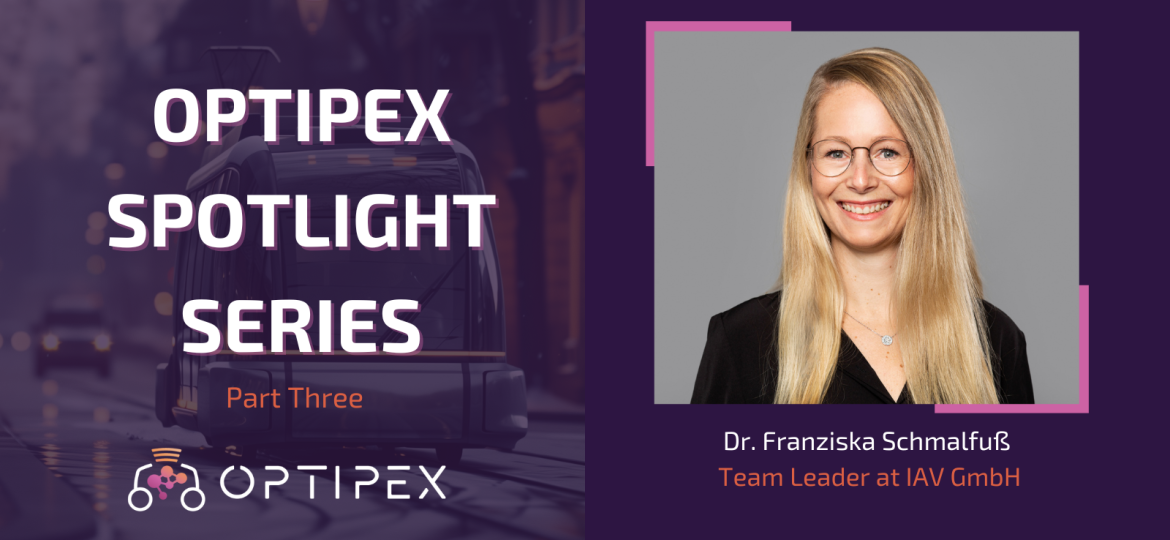
Welcome to the third edition of OptiPEx’s Spotlight Series! In this edition, we sit down with Dr. Franziska Schmalfuß, Project Manager at the Department of Intelligent Driving Functions at IAV GmbH, to explore her organization’s role in the OptiPEx project.
Thank you for speaking with us today. Could you start by introducing yourself?
I am Dr. Franziska Schmalfuß, a team leader in the Department of Intelligent Driving Functions at IAV GmbH, located in Chemnitz, Germany. My expertise lies in human factors within the development of highly automated driving systems at IAV.
What does your organisation do?
IAV GmbH is a leading engineering company specializing in the development of innovative technologies and solutions for the automotive, mobility, and energy sectors. Our engineering solutions are applied in vehicles and technologies worldwide, regardless of the manufacturer. With over 40 years of experience and an extensive range of expertise, we merge the realms of automotive and IT, hardware and software, as well as products and services. Our goal is to improve the mobility of the future.
Can you tell us about your general experience with public transport in your city?
Public transport in Chemnitz is well-developed and includes a network of trams, buses, and regional trains operated by Chemnitzer Verkehrs-AG (CVAG) and Verkehrsverbund Mittelsachsen (VMS), two cooperating transport providers. The city offers reliable and frequent services, making it convenient for residents and visitors to navigate the city and its surroundings. However, there is room for improvements to address special user needs and for innovative solutions for sub-urban areas. Highly automated shuttles are particularly promising for enhancing the flexibility of public transport services and addressing challenges like the shortage of bus drivers.
Based on this, why is a project like OptiPEx necessary?
Heading towards the future of highly automated shuttle fleets, it is essential to investigate special user needs and develop intelligent solutions to address identified barriers. OptiPEx goal reflects this topic and will push the acceptability, perceived safety and comfort of automated shuttles and other public transport services. The interdisciplinary cooperation will assure that the actual state of the art in research, competences in technology development in autonomous driving as well as public transport, and overall industry needs are combined when solutions will be developed. Only the collaboration of all different parties will lead to solutions that are widely adaptable to actual public transport services to increase comfort and safety.
What role does your organisation play in the OptiPEx project?
IAV possesses extensive expertise in the development of highly automated vehicles, R&D projects in the automotive sector, and the support of series production. We, at IAV, have experts in all project-related topics, such as Human Factors in automotive, In-Cabin-Monitoring, user-specific solution in public transport (e.g. WonderVision), as well as vehicle integration.
We will analyse passenger and stakeholder requirements for safer and more comfortable, highly automated public transport. In addition, we will advance vehicle technologies by incorporating AI algorithms for In-Cabin Monitoring to detect scenarios where passengers require special assistance.
Furthermore, we will also provide one of the three living labs by integrating and testing OptiPEx solutions in a highly automated shuttle with potential passengers and evaluate them.
What will a successful contribution to the project look like for your organization?
Our Goal is to provide solutions for passengers of our highly automated shuttle to feel safe and comfortable while using public transport, with focus on the ones with special needs.
What do you see as the biggest challenge for the project?
I think the biggest challenge for OptiPEx lies in AI algorithm development for anomaly detection, in-cabin monitoring or target group detection. For a great solution you need lots of well- labelled, sometimes sensitive data such as video and audio recordings. We aim to tackle this challenge by utilizing open-source data, our own recordings, and cutting-edge methods to reduce the need for training data.
What does your organization hope to achieve between now and month 18 of the project?
The first 18 months will lead to a clearer understanding of the user needs and to first important technology developments as well as initial test results. Regarding user needs, we want to focus on the special needs of passengers when no driver will be available in e.g. future buses; what problems should be addressed and how could passenger be supported. Meanwhile the development of algorithms for in-cabin monitoring will proceed with the aim of identifying anormal situations in public transport that will be the trigger for OptiPEx solutions in the vehicle or infrastructure.
Can you describe OptiPEx in three words?
Three words is not much, so let’s try the German way of putting words together 🙂 Innovative, user-adaptive public-transport-solutions.